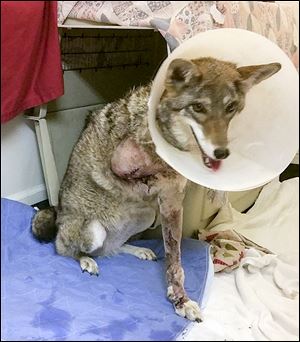
Rescued coyote attacked, loses leg
Other animals injured 4-year-old
6/20/2016One of the most beloved animals at Nature’s Nursery Center for Wildlife Rehabilitation and Conservation Education is adapting to life on three legs.
Staff found Rue, the center’s 4-year-old coyote, badly injured the morning of June 8. It appeared at least two wild coyotes managed to pull her right front leg through the chain link fence of her outdoor enclosure the night before.

Rue, Nature’s Nursery’s 4-year-old education program coyote, adjusts to life with a missing leg.
“They could have just gotten the tip of a paw and pulled her through,” Laura Zitzelberger, operations manager, said. “It was just massive injury the whole length of the leg.”
Though there were no broken bones, extreme injury to the tissue would have required extensive and very stressful treatment for the skittish, sensitive animal.
“It would have required multiple skin grafts,” said Dr. Bart Soeder of Heatherdowns Veterinary Clinic in Toledo. “I agreed wholeheartedly that the best way to go was amputation.”
The amputation completed June 9 is allowing Rue to heal faster and without such invasive handling. Dr. Soeder said Rue, like domestic canines, should heal completely after a few weeks and do very well as a tripod.
While she recovers, Rue is being kept in a walk-in closet at the center near Whitehouse — the same closet she occupied as a pup when she arrived in 2012.
Steve Kiessling, executive director, said Rue is one of only a handful of captive coyotes in Ohio. She became an education animal for the center after someone illegally snatched the pup from her mother’s den and tried to domesticate her.
“She’s not a pet,” Mr. Kiessling said. “We are responsible for her now because someone tried to make her a pet. And now we are making sure she has the best life possible as a coyote in captivity. The only alternative was euthanasia.”
Staff has seen evidence over the years, such as paw prints and scat, that wild coyotes have visited Rue before. But there was never concern for her safety behind the 8-foot fence completed by an angled top with rolling pipes. Mrs. Zitzelberger said Rue doesn’t generally get too close to or touch the fence because she is startled by its slight movement with her weight.
“You just can’t predict every possible thing that might happen,” Mrs. Zitzelberger said. “It’s hard to make enclosures 100 percent safe and still have an enriching environment for the animal.”
Since Rue would never be happy living indoors, the organization will replace a split-rail barrier fence surrounding the coyote’s enclosure with a second chain-link fence. Mr. Kiessling expects it to cost several thousand dollars.
“It’s an unwanted and unplanned expense for us right now during our busy season,” he said.
Nature’s Nursery takes in an average of about 30 animals per day this time of year. Aside from the bills, Rue’s injury has created additional complications.
The closet she is temporarily occupying was previously an isolation space for squirrels with mange. Those animals had to be shifted to an outdoor enclosure.
Mr. Kiessling noted Rue responds well only to Mrs. Zitzelberger and one other staff member.
So those two individuals are visiting her at various times around the clock to care for her, affecting their ability to complete other tasks.
“We’re figuring out how to cover everything,” Mr. Kiessling said.
Donations to Nature’s Nursery may be made at natures-nursery.org, or by sending a check to P.O. Box 2395, Whitehouse, OH, 43571.
Contact Alexandra Mester: amester@theblade.com, 419-724-6066, or on Twitter @AlexMesterBlade.